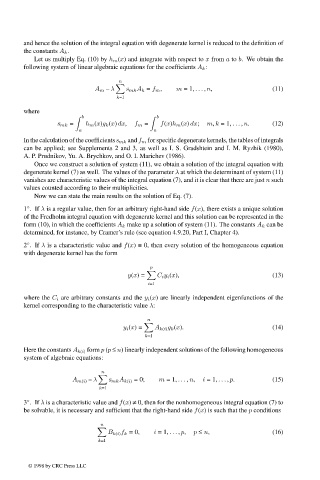Page 548 - Handbook Of Integral Equations
P. 548
and hence the solution of the integral equation with degenerate kernel is reduced to the definition of
the constants A k .
Let us multiply Eq. (10) by h m (x) and integrate with respect to x from a to b. We obtain the
following system of linear algebraic equations for the coefficients A k :
n
A m – λ s mk A k = f m , m =1, ... , n, (11)
k=1
where
b b
s mk = h m (x)g k (x) dx, f m = f(x)h m (x) dx; m, k =1, ... , n. (12)
a a
In the calculation of the coefficients s mk and f m for specific degenerate kernels, the tables of integrals
can be applied; see Supplements 2 and 3, as well as I. S. Gradshtein and I. M. Ryzhik (1980),
A. P. Prudnikov, Yu. A. Brychkov, and O. I. Marichev (1986).
Once we construct a solution of system (11), we obtain a solution of the integral equation with
degenerate kernel (7) as well. The values of the parameter λ at which the determinant of system (11)
vanishes are characteristic values of the integral equation (7), and it is clear that there are just n such
values counted according to their multiplicities.
Now we can state the main results on the solution of Eq. (7).
1 .If λ is a regular value, then for an arbitrary right-hand side f(x), there exists a unique solution
◦
of the Fredholm integral equation with degenerate kernel and this solution can be represented in the
form (10), in which the coefficients A k make up a solution of system (11). The constants A k can be
determined, for instance, by Cramer’s rule (see equation 4.9.20, Part I, Chapter 4).
2 .If λ is a characteristic value and f(x) ≡ 0, then every solution of the homogeneous equation
◦
with degenerate kernel has the form
p
y(x)= C i y i (x), (13)
i=1
where the C i are arbitrary constants and the y i (x) are linearly independent eigenfunctions of the
kernel corresponding to the characteristic value λ:
n
y i (x)= A k(i) g k (x). (14)
k=1
Here the constants A k(i) form p (p ≤ n) linearly independent solutions of the following homogeneous
system of algebraic equations:
n
A m(i) – λ s mk A k(i) =0; m =1, ... , n, i =1, ... , p. (15)
k=1
◦
3 .If λ is a characteristic value and f(x) ≠ 0, then for the nonhomogeneous integral equation (7) to
be solvable, it is necessary and sufficient that the right-hand side f(x) is such that the p conditions
n
B k(i) f k =0, i =1, ... , p, p ≤ n, (16)
k=1
© 1998 by CRC Press LLC
© 1998 by CRC Press LLC
Page 531

